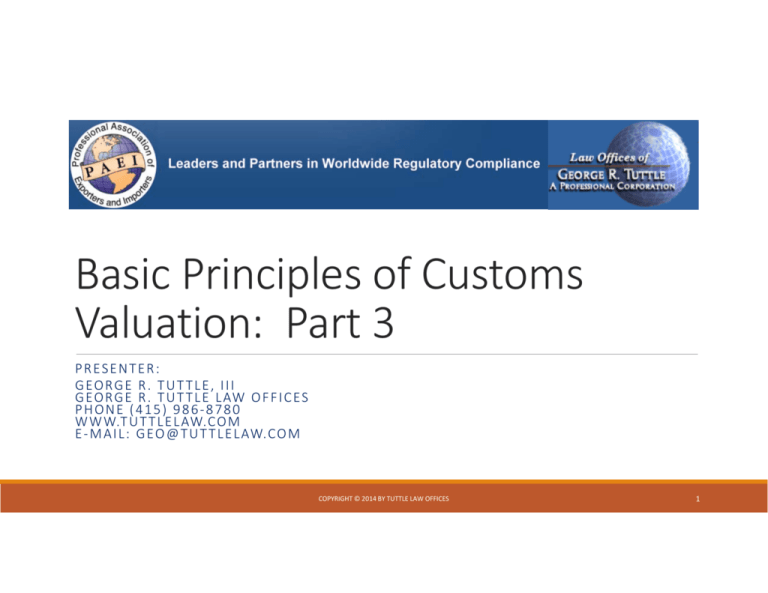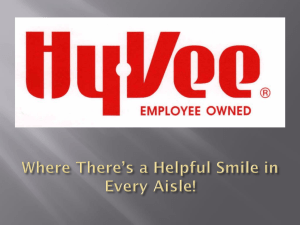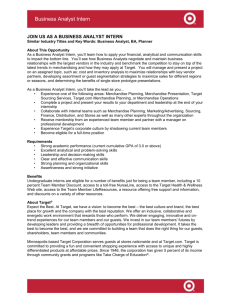Basic Principles of Customs Valuation: Part 3
advertisement

Basic Principles of Customs Valuation: Part 3 PRESENTER: G EO R G E R . T U T T L E , I I I G EO R G E R . T U T T L E L AW O F F I C ES PHONE (415) 986‐8780 W W W.T U T T L E L AW.CO M E ‐ M A I L : G EO @ T U T T L E L AW.CO M COPYRIGHT © 2014 BY TUTTLE LAW OFFICES 1 Current Hot Topics in Customs Valuation What is covered in this Webinar? ◦ Valuation of Consignments, Samples, Demo & Evaluation Units, Returns and Repairs and Defective Merchandise ◦ The other methods of valuation ◦ Reporting value changes: PEAs, PSCs, and ◦ CBP’s Reconciliation Program COPYRIGHT © 2014 BY Tuttle Law Offices Page 2 Valuation Fundamentals Key Resources, cont. ◦ Customs Rulings: http://rulings.cbp.gov/ ◦ Customs Informed Compliance Publications ◦ http://www.cbp.gov/trade/rulings/informed‐compliance‐publications ◦ Customs Value ◦ Customs Valuation Encyclopedia (1980 ‐ 2010) ◦ Determining the Acceptability of Transaction Value for Related Party Transactions ◦ Bona Fide Sales & Sales for Exportation to the United States ◦ Proper Deductions for Freight & Other Costs ◦ Buying & Selling Commissions ◦ Reasonable Care COPYRIGHT © 2014 BY Tuttle Law Offices Page 3 Valuation Fundamentals Customs value law (1401a) provides for five methods of appraisement of merchandise Must be applied in sequential order: ◦ Transaction value ◦ Transaction value of identical or similar merchandise ◦ Deductive value ◦ Computed value ◦ A derived (fall‐back) method reasonably adjusted to circumstances COPYRIGHT © 2014 BY Tuttle Law Offices Page 4 Valuation Fundamentals What is Transaction Value? ◦ Defined as: “transaction value of imported merchandise is the price actually paid or payable for the merchandise when sold for exportation to the United States”,. . . [plus stated statutory additions] COPYRIGHT © 2014 BY Tuttle Law Offices Page 5 Transaction Value: What is a Sale? In order for imported merchandise to be appraised under transaction value • It must be the subject of a sale between a buyer and seller, and • It must be a sale for exportation to the United States. Is there a “sale”? • The word "sale" is generally defined as a transfer of ownership in property from one party to another for a price or other consideration. J.L. Wood v. United States, 62 CCPA 25, 33, C.A.D. 1139, 505 F.2d 1400, 1406 (1974) COPYRIGHT © 2014 BY TUTTLE LAW OFFICES 6 Transaction Value: Is There a Sale? WTO Customs Value Code Technical Committee Advisory Opinion 1.1 Advisory opinion lists situations in which imported goods would not be deemed to have been the subject of a sale. • Free consignments (samples, gifts, etc.) • Goods imported on consignment (consignment sales) • Goods imported by intermediaries who do not purchase the goods but who sell them after importation • Goods imported by branches which are not separate legal entities • Goods imported under a lease contract or on loan • Goods consisting of waste or scrap imported for destruction COPYRIGHT © 2014 BY TUTTLE LAW OFFICES 7 Transaction Value: What is a Sale? Imports of consigned goods, samples, returns, return for repair, demos and defective merchandise do not generally involve a sale for a price or “other” consideration. • Note: some transactions may be subject to an agreement so need to check, i.e., inter‐company agreement or warranty exchange program (replacement could be viewed as “other consideration”). • Transactions that anticipate a sale “after” importation do not qualify as Transaction Values because the “sale” did not cause the exportation and the sale is not “fixed” at the time of exportation. COPYRIGHT © 2014 BY TUTTLE LAW OFFICES 8 Transaction Value: What is a Sale? If no Transaction Value, then what? Apply other methods of appraisement in order of statute: • Transaction value of identical or similar merchandise • Deductive value • Computed value • A derived (fall‐back) method reasonably adjusted to circumstances COPYRIGHT © 2014 BY TUTTLE LAW OFFICES 9 Value of Identical or Similar Merchandise The transaction value of “identical” or “similar merchandise” is based on sales to the United States to an unrelated party: • At the same commercial level and • In substantially the same quantity of merchandise exported to the United States • At or about the same time as merchandise being appraised. See 19 U.S.C. 1401a(c). “Identical Merchandise” means: • Physically identical in all respects, • Produced in the same country and by the same party* • CBP Regs provides that “minor differences” in appearance will not preclude otherwise conforming merchandise from being considered "identical". See 152.102(d). COPYRIGHT © 2014 BY TUTTLE LAW OFFICES 10 Value of Identical or Similar merchandise "similar merchandise" means • produced in the same country by the same person* • is “like” the merchandise being appraised in characteristics and component material, and • is commercially interchangeable with the merchandise being appraised • CBP regs provide that “quality of the merchandise, its reputation, and the existence of a trademark will be factors considered to determine whether merchandise is "similar".” See 152.102(i). Values may be adjusted to take account for differences in commercial level and/or quantity. The lower or lowest values of multiple comparable transactions must be used. Any comparable merchandise that incorporates or reflects any U.S. provided engineering, development, artwork, design work, or plan or sketch free of charge, etc., is precluded. Difficult to find TV of “identical” or “similar merchandise” unless merchandise is demo or evaluation unit. COPYRIGHT © 2014 BY TUTTLE LAW OFFICES 11 Deductive Value: 19 U.S.C. 1401a(d) Under Deductive Value, merchandise is appraised on the basis of: • The price sold in the U.S. in its condition as imported • First unrelated party • In the greatest aggregate quantity either: At or about the time of importation, or Before the close of the 90th day after the date of importation. See 19 U.S.C. 1401a(d)(2)(A)(i)‐(ii). Resale price is subject to certain enumerated deductions. See 19 U.S.C. 1401a(d)(3). • International transportation and related costs • Customs duties and fees/ brokerage charges, delivery to customer • Selling expenses (Note: not general G & A) and profit on sales of same class or kind. Any sale to a person who supplies any assist in connection with the production or sale for export of the merchandise shall be disregarded COPYRIGHT © 2014 BY TUTTLE LAW OFFICES 12 Super‐Deductive Value Same rules as Deductive Value but applies to imported goods subject to “further processing” (manufacture, assembly, repair, refurbishment, etc.) • Unit price sold in greatest aggregate quantity to unrelated persons • Sold on or before 180th day after importation. Deductions made for the value added by processing and materials relating to the cost of the work performed Deductive Value may be applicable to consignments, returns, defective goods, etc., that have been, serviced, refurbished, repaired, etc., and sold. If the imported merchandise maintains its identity but forms a minor element of the merchandise sold in the United States, the use of Super Deductive Value will be “unjustified.” See 152.105(h)(3) Exchange programs are not the same as sales. COPYRIGHT © 2014 BY TUTTLE LAW OFFICES 13 Computed Value: 19 U.S.C. 1401a(e) Under Computed Value, merchandise is appraised on the basis of: • Materials and processing costs incurred in the production of imported merchandise, plus • An amount for profit and general expenses of the parent company equal to that usually reflected in sales of merchandise of the same class or kind, and • The value of any assists and packing costs. See 19 U.S.C. 1401a(e)(1). Computed value does not apply if the exporter does not produce the imported merchandise Materials and processing costs must be actual not “standard cost” Consideration of variances for merchandise under appraisement Profit and general expenses relate only to sales of merchandise of the same class or kind not all divisions or businesses COPYRIGHT © 2014 BY TUTTLE LAW OFFICES 14 The “Fallback" Method When merchandise cannot be appraised under one of the methods set forth in 19 U.S.C. 1401a(b)‐(e), its value is to determined in accordance with the "fallback" method set forth in section 1401a(f). Fallback method provides that merchandise should be appraised on the basis of a value derived from one of the (b)‐(e) methods, reasonably adjusted to the extent necessary to arrive at a value. Examples: Identical merchandise or similar merchandise: • • The requirement that merchandise, should be exported at or about the same time of exportation as the merchandise being appraised may be interpreted flexibly. Identical merchandise, or similar merchandise, produced in any country other than the country of exportation or production of the merchandise being appraised may be the basis for customs valuation. Merchandise sold after the 90th day after importation must be appraised under the fallback method, i.e. section of 402(f) of the TAA, using a modified deductive value approach. 546442, dated Mar. 23, 1999. COPYRIGHT © 2014 BY TUTTLE LAW OFFICES 15 Prohibited Methods of Appraisement Value statute (1401a(f)(2)) prohibits use of: ◦ U.S. Selling price of similar merchandise produced in the United States; ◦ Appraisement of imported merchandise at the higher of two alternative values; ◦ Price of merchandise in the domestic market of the country of exportation; ◦ Cost of production, other than “computed value” under the statute for merchandise that is identical or similar to the merchandise being appraised; ◦ The price of merchandise for export to a country other than the United States; ◦ Minimum values for appraisement; or ◦ Arbitrary or fictitious values. COPYRIGHT © 2014 BY Tuttle Law Offices Page 16 Section 1500 19 U.S.C. 1500(a) constitutes CBP'S general appraisement authority. Under 19 U.S.C. 1500(a) the appraising officer may fix the final appraisement of merchandise by ascertaining or estimating the value of the merchandise: • by all reasonable ways and means in his power • notwithstanding any statement of cost or costs of production in any invoice, affidavit, declaration, other document to the contrary …" It is not a separate basis of appraisement and cannot be used as such. Section 1500 allows CBP to consider the best evidence available in appraising merchandise. COPYRIGHT © 2014 BY TUTTLE LAW OFFICES 17 Leases HQ 545112 , June 7, 1993 • 19 U.S.C. 1500(a) requires CBP to "appraise merchandise by ascertaining or estimating the value thereof." Accordingly, CBP is to appraise the value of leased merchandise as opposed to the value of the merchandise to the importer. • 542996, Mar. 4, 1983 • The transaction value method can be reasonably adjusted to permit the rental value of the equipment over its full economic life to represent the value of the merchandise. Transaction value may not be used to appraise merchandise imported pursuant to a lease agreement with an option to buy. In the absence of an alternative basis of appraisement, a value may be based upon transaction value, reasonably adjusted to arrive at a value. Customs Valuation Encyclopedia • In the case of goods which have been used, valuation may be based on a valid list price for new goods in the absence of a valid list price for used goods. Such list prices for new goods must be adjusted to take into account the depreciation and obsolescence. COPYRIGHT © 2014 BY TUTTLE LAW OFFICES 18 Importing Used Articles CBP has issued several rulings on the subject of importing used articles to be repaired in the U.S. • In many of the cases, value was determined using the fallback method derived from a prior method, e.g.: • Transaction value or deductive value with reasonable adjustments to take into account the fact that the goods were imported to be repaired and were used goods COPYRIGHT © 2014 BY TUTTLE LAW OFFICES 19 Used articles Imported For Repaired HRL 547877 , dated January 23, 2002 • Ruling involved equipment returned to the U.S. for repair • All parties agree that the proper basis of appraisement for the imported repair items is 19 U.S.C. 1401a(f) as none of the other preceding means of appraisement under 19 U.S.C. 1401a(b)‐(e) is applicable • CBP agreed that two deductions from the new sales price list was permissible: One for the repair and One for depreciation. COPYRIGHT © 2014 BY TUTTLE LAW OFFICES 20 Used Articles Imported for Repaired HRL 548688, dated October 20, 2005 • Addressed valuation of merchandise returned to the United States for evaluation and repair or recalibration • Units were imported for evaluation and repair or recalibration at no charge to the customer under a "depot exchange program" or "DEP". • Units were not resold (no deductive value) • Units were originally made in U.S. or at related foreign assembly facility • Importer could not at time of importation access the unit's original selling price or determine the nature or extent of repairs required COPYRIGHT © 2014 BY TUTTLE LAW OFFICES 21 Rulings on Valuation of Returns HQ H167495 (2011) • Valuation of various aerospace components imported for overhaul, repair or testing • The methods of appraisement found in 19 U.S.C. 1401a(c), (d) and (e) are not available • Allowed: A deduction for depreciation A deduction based on the average cost of repair per unit based on the previous year's repair cost of each unit divided by the number of units repaired during the year from the World List Price H229800 (2013) Appraisement of used gas turbine parts (used set of blades) • Pursuant to 19 U.S.C. 1401a(f), the method of appraisement proposed by counsel for the importer to use the standard replacement cost of the raw materials formed into the shape of the pre‐ finished component and to apply a factor of 0.5 to account for the value of the repair is a reasonable way and means to appraise the used parts. COPYRIGHT © 2014 BY TUTTLE LAW OFFICES 22 Other Rulings on Valuation of Returns Other important rulings on the valuation of returns HQ H019710 (2009) appraisement for repaired merchandise and merchandise in need of repair – no sales • In the case of merchandise (OEM) price list, CTDI may use a fallback method based upon that information, deducting for depreciation and, in the case of the imported repaired merchandise, the average cost of repair of the individual units. For merchandise for which CTDI does not have the OEM price, CTDI may use book values recorded in its books that reflect the value of the repaired products, or, in the absence of book values, price quotes by reputable U.S. resellers for identical or similar repaired items. See HQ W548618. HQ H020270 (2008) damaged transmission cores imported for use in the production of rebuilt automobile transmissions • Affected merchandise could be appraised under the "super deductive" value method of appraisement, "reasonably adjusted" to the extent necessary to arrive at a value. The imported used transmission cores may be appraised based on the formula proposed by American Honda that uses the current U.S. list price, reflecting the cost of a new transmission, adjusted by deducting the weighted average cost of rebuilding the article (replacement parts, labor and administrative), as described above, calculated on a twice‐yearly basis. COPYRIGHT © 2014 BY TUTTLE LAW OFFICES 23 Other Rulings on Valuation of Returns HQ W563557 (2006) (Seagate Ruling) Valuation of Defective and Repaired Disc Drives • Defective drives returned to the United States for repair may be appraised under the fallback valuation method • Refurbished disc drives should be appraised using the deductive value method. If they do not so qualify, they should be appraised under the fallback method, using a modified deductive value, HRL 548211 (2003) – Valuation of PCBA for IC testers returned as a part of upgrade program or because of failure at 10% or 40 %of new list price depending on reason for return. HRL 544377 (1989) use of inventory value in the importer's accounting records to appraise telephone equipment returned for repair. inventory value was based on % of the standard cost of new equipment COPYRIGHT © 2014 BY TUTTLE LAW OFFICES 24 Post Entry Corrections: PEAs and PSCs http://www.cbp.gov/trade/entry‐ summary/post‐entry‐amendment COPYRIGHT © 2014 BY TUTTLE LAW OFFICES 25 COPYRIGHT © 2014 BY TUTTLE LAW OFFICES 26 Post Entry Corrections: PEAs and PSCs Post Entry Amendments (PEAs) Procedure applies to • Revenue differences (over and under payment of duties) ◦ Quantity ◦ Value ◦ Classification ◦ Duty (AD, GSP, AGR, etc.) Statistical & Non‐revenue: ◦ Country of origin ◦ Quantity ◦ Value ◦ Classification ◦ Miscellaneous charges COPYRIGHT © 2014 BY TUTTLE LAW OFFICES 27 Correcting Errors: The PEA Process Individual PEAs Entry errors exceeding $20 in revenue (duty or MPF) or any ADD revenue related error Non‐revenue errors involving quota or textile merchandise and relate to C/O, quantity, visa #, or HTS # Non‐revenue errors not involving quota or textile merchandise i.e., not effecting duty, NDC’s) exceeding $10,000 ◦ Country of origin ◦ Quantity ◦ Value ◦ Classification ◦ Non Dutiable Charges ◦ Non‐quota merchandise of CH 50 to 65 subject to a textile category # where the value of the error is $3,000 or more COPYRIGHT © 2014 BY TUTTLE LAW OFFICES 28 Correcting Errors: The PEA Process Quarterly Tracking Reports • Revenue errors not exceeding $20 and • Non‐revenue errors not involving quota or textile merchandise, such as: Country of origin Quantity Value or Classification not effecting duty NDC’s Not exceeding $10,000 may be consolidated and reported quarterly to CBP COPYRIGHT © 2014 BY TUTTLE LAW OFFICES 29 Post Entry Amendment Cover Form COPYRIGHT © 2014 BY TUTTLE LAW OFFICES 30 Correcting Errors: The PEA Process A single PEA will consist of a: • PEA coversheet, • Revised CBP Form 7501, and any additional documentation needed to support the amendment, if appropriate. • Pen and ink corrections annotated on the CBP Form 7501 are acceptable. If CBP disagrees with a PEA issue, CBP will liquidate the entry summary as entered and will place the entry in the two‐week liquidation cycle. (Watch for this.) If a filer disagrees with CBP's determination, they must file a protest under 19 U.S.C. 1514. If the PEA is not the proper vehicle for the claim, the PEA will be returned to the filer without further process. PEA’s must be filed 20 days prior to liquidation of the entry to be processed. COPYRIGHT © 2014 BY TUTTLE LAW OFFICES 31 Post Summary Corrections (PSCs) PSCs are the only means for making electronic corrections via the Automated Commercial Environment (ACE) on entry summary data ACE entry type 01 and 03 entry summary. Type 11 informal entries are NOT eligible for post summary corrections PSCs replace the entry in its entirety PSCs can only be filed by an ACE filer (but not necessarily the same original filer) PEAs will not be accepted for ACE entries COPYRIGHT © 2014 BY TUTTLE LAW OFFICES 32 COPYRIGHT © 2014 BY TUTTLE LAW OFFICES 33 Reconciliation! CBP’s Recon program • http://www.cbp.gov/trade/entry‐ summary/reconciliation • Must apply for program and post bond rider • Applies only to entries after acceptance • Responsibility of the port at which the underlying entry was filed to determine the basis of appraisement • The responsibility of the reconciliation processing port to verify the accuracy of post‐importation adjustments Unresolved appraisement issues • • Statutory basis of appraisement, transfer pricing, related party transactions, etc. Are to be resolved at the port where the underlying entry was filed for resolution and acceptance. The originating port of entry may pursue corrective action against the Customs broker and/or the importer participating in reconciliation regarding the unresolved appraisement issue(s) COPYRIGHT © 2014 BY TUTTLE LAW OFFICES 34 What is Entry Reconciliation? “Reconciliation” is both a process and a type of customs entry (Entry Type Code 09) ACS entry reconciliation was added to 19 USC 1481 by Customs Mod Act of 1993 Allows importer to file entry summaries using the “best available information” and Electronically “flag” data elements that are estimated Importer subsequently provides “actual” information on a “Reconciliation” entry (can cover one or hundreds of individual entries) COPYRIGHT © 2014 BY TUTTLE LAW OFFICES COPYRIGHT © 2014 BY Tuttle Law Offices 35 What is Entry Reconciliation? “Elements” of the entry that are flagged for reconciliation are withheld from liquidation while all non‐flagged elements are liquidated as entered ACS Reconciliation does not change or replace existing laws regarding the reporting of value Provides a new process for amending data that was previously provided to CBP ACS Reconciliation is the “primary” means for making post‐summary adjustments ◦ Value ◦ HTSUS Heading 9802 value ◦ Certain Free trade agreement claims (NAFTA) ◦ Generally not classification Failure to file a timely reconciliation will result in the assessment of a liquidated damage claim COPYRIGHT © 2014 BY Tuttle Law Offices 36 Time Frames for Filing Recon Entry 520(d) Reconciliations have a separate deadline from Reconciliations of other issues. Certain free trade agreements – • North American Free Trade Agreement, • The United States‐Chile Free Trade Agreement, • The Dominican Republic‐Central America‐United States Free Trade Agreement, • The United States‐Oman Free Trade Agreement, • The United States‐Peru Trade Promotion Agreement Implementation Act, • The United States‐Panama Trade Promotion Agreement, • The U.S.‐Korea Free Trade Agreement and the United States‐Colombia Trade Promotion Agreement is 12 months from the earliest import date. Valuation, 9802 and classification is 21 months from earliest summary date. COPYRIGHT © 2014 BY TUTTLE LAW OFFICES 37 Entry Recon Flagging “Flagging”: • Identifies unknown information • Transfers liability for those issues to a Reconciliation • Permits the liquidation of the remainder of the entry summary • Notifies CBP of importer’s intent to file a Reconciliation covering that entry summary Filer may flag entries via an individual entry flag or a blanket flag • Individual entry flagging – The entry filer flags the underlying entries on the header record of an entry summary at the time of filing COPYRIGHT © 2014 BY TUTTLE LAW OFFICES 38 Entry Recon Flagging Blanket Flagging • A flag is automatically added by CBP to all entries for all ports made under the recon filer’s importer of record number • This means each entry summary must be closed by a Reconciliation, even those entries that do not require adjustments • Importers who wish to obtain reports of flagged entries may do so by contacting CBP National Finance Center If an entry summary is flagged for value, a PEA or PSC should not be filed on that entry. The issue flagged is no longer addressable on the underlying entry. ASC Reconciliation Handbook, December 2004 COPYRIGHT © 2014 BY TUTTLE LAW OFFICES 39 Types of Reconciliations Two types of Reconciliations may be filed: • Entry‐by‐Entry • Aggregate For both, the Reconciliation will consist of: • A Header Page, • Association file, and • Summarized line item data spreadsheet COPYRIGHT © 2014 BY TUTTLE LAW OFFICES 40 Types of Reconciliations Entry‐by‐Entry Reconciliation • This Reconciliation is a detailed submittal in which the revenue adjustment is specifically provided for each affected entry summary. • The revenue adjustment must be broken down to entry‐by‐entry detail for all underlying entry summaries on the association file submitted through ABI. COPYRIGHT © 2014 BY TUTTLE LAW OFFICES 41 Types of Reconciliation Aggregate Reconciliation • This option consolidates all entries covered in the Reconciliation • Applies generally to those situations that involve an increase • The association file for the Aggregate Reconciliation only requires a list of all underlying entries and not the revenue adjustment broken down by entry • Importer waives any refunds through the reconciliation filing process for aggregate recon filing COPYRIGHT © 2014 BY TUTTLE LAW OFFICES 42 Types Of Reconciliation Decision of which type to use (entry‐by‐entry or aggregate) will depend on: • Specific facts of your case • Do you expect refunds? In some ways entry‐by‐entry is easier once all of the data is in. COPYRIGHT © 2014 BY TUTTLE LAW OFFICES 43 Aggregate Reconciliations The Header Sheet The Reconciliation header provides general information about the recon, including: • The Reconciliation entry number The type of Reconciliation The issues on Reconciliation The grand totals for duties and fees, both original and reconciled Interest COPYRIGHT © 2014 BY TUTTLE LAW OFFICES 44 Values must be within $20 of CBP information COPYRIGHT © 2014 BY TUTTLE LAW OFFICES 45 Aggregate and Entry‐by‐Entry Reconciliation The major difference between Aggregate and Entry‐by‐Entry Reconciliation is the structure of the association file • The association file contains a list of affected entry summaries flagged for Reconciliation sorted by Port code where they were filed • For Entry‐By‐Entry Reconciliation, the following elements are also required: The actual amount of fees (broken out by class code), duties and fees, deposited per underlying entry summary The reconciled amount of fees (broken out by class code), duties, and fees owed for each underlying entry COPYRIGHT © 2014 BY TUTTLE LAW OFFICES 46 Aggregate and Entry‐by‐Entry Reconciliation Summarized Line Item Data Spreadsheet • The third element of the Reconciliation must show, at a macro level, all substantive changes reported in the Reconciliation. • The data must be presented in a standard format (see sample spreadsheet) • The data elements in the spreadsheet are the same for both Entry‐by‐Entry and Aggregate Reconciliations COPYRIGHT © 2014 BY TUTTLE LAW OFFICES 47 Summarized Line Item data Spreadsheet COPYRIGHT © 2014 BY Tuttle Law Offices 48 Aggregate and Entry‐by‐Entry Reconciliation Summarized Line Item Data Spreadsheet • The summarized line item data spreadsheet captures adjustments that have an effect on reportable data elements declared throughout the reconciliation period without reference to the underlying entry numbers • Each combination of HTS, country of origin, special program indicator (SPI), and calendar year of release (per Census requirements) will require a separate line. • Each spreadsheet line is to show the original and reconciled data. The original data is extracted from the rolled‐up groupings of the entry lines from flagged entries The reconciled data is either input manually or prorated automatically via formula COPYRIGHT © 2014 BY TUTTLE LAW OFFICES 49 Customs Validation of Data CBP compares information on duty/fees paid • From Header record, association file and summary line item data file against • Customs liquidation extract report Recon entry will be rejected of there is a difference in original total duty/fees paid of more than $20. CAUTION: any PSC, PEA or protest filed on an entry summary flagged for reconciliation and the potential to impact “total duty/fees paid.” Watch for different IOR’s and different bond numbers! COPYRIGHT © 2014 BY TUTTLE LAW OFFICES 50 Reconciliation entries are subject to post‐entry audits Importers should document • Recon methodology with Port • Maintain records of Value additions Method of allocation to entries Recon filing and supporting schedules Documents to support FTA claims Retain documents for full recordkeeping period COPYRIGHT © 2014 BY TUTTLE LAW OFFICES 51 But How Do I Reconcile? This is very fact specific Valuation cases ◦ What is your value issue? ◦ Assists and supplemental payments? ◦ Related party valuation adjustments? ◦ Apportionment to specific products or entries ◦ Apportionment to all flagged entries ◦ Basis of appraisement, method of determine value addition, and method of apportionment needs to be worked out with CBP I/S team beforehand COPYRIGHT © 2014 BY TUTTLE LAW OFFICES 52 About your Speaker George Tuttle is an attorney with the law firm of George R Tuttle Law Offices in San Francisco. He has been in practice for over 25 years. George’s practice emphasis is on Customs, international trade regulation, and export compliance. He works with both small and large clients, as well as customs brokers and freight forwarders with import and export related matters. He assists companies with compliance audits and to develop effective compliance programs; determine correct customs, duties, values, product classifications, and duty preference eligibility; obtain rulings, file protests; and resolve penalty, seizure and enforcement cases. He and the firm also litigate matters before the United States Court of International Trade (CIT) and the Court of Appeals for the Federal Circuit (CAFC) in Washington D.C. Additional information about Mr. Tuttle can be found at www.tuttlelaw.com. COPYRIGHT © 2014 BY TUTTLE LAW OFFICES 53



